Shameem Akthar
Shameem Akthar, yogacharya, trained with the Sivananda Yoga Vedanta Center, Kerala, shows a few poses will cure your digestion problems.
In yoga, for digestive problems most asanas are helpful. You may however have to avoid them when there is an inflammatory condition like ulcer or any perforated condition of the digestive tract.
In fact, to have a gentle yoga practice when you have a digestive problem will soothe the stomach. Even where poses are suggested that apply pressure on the abdomen, care must be taken not to press down into them, but to hold the poses lightly.
Including soothing pranayama practices like seethali (cooling breath) and the alternate nostril breathing (anulom vilom) are also helpful.
The most soothing practice, in yoga, for healing digestive disasters, including inflammatory conditions, however is the passive practice of meditation. A ten-minute meditation, lying supine in the corpse pose (shavasana) or the prone as in the crocodile (makarasana) will be the best therapy.
In yoga, apart from actual incidents of food poisoning most other ailments are tracked to psychosomatic causes or life-style mismanagement. Having a regular meal schedule, giving sufficient gap between eating and exercising/or sleeping, waking up early, eating dinner early, are some simple tips to maintain a healthy gut.
Shameem Akthar, yogacharya trained with the Sivananda Yoga Vedanta Center, takes you through five poses that will help in controlling digestive ailments.
Shashankasana (Hare pose)
Image: Shashankasana (Hare pose)Sit on your heels, with the big toes touching each other. Raise your hands up, inhaling. Exhaling lower them as shown. Place forehead on the ground and stay in this pose for a minute or so.
Raise hands to return to the base position, inhaling. You may hold this pose after the first few attempts for longer. If you need, you may place a cushion at the forehead to ease the breath, especially if you are not very flexible.
Benefits: The gentle pressure on the stomach soothes the digestive tract. Controls diabetes and acidity. Promotes digestion by redirecting blood from legs to the stomach and torso. Soothes the mind, the remove the psychosomatic triggers for stomach problems.
Gatyakmakmeruwakrasana (Dynamic spinal twist)
Image: Gatyakmakmeruwakrasana (Dynamic spinal twist)Sit with your legs spread out as shown. Keep spine erect and legs as straight as possible (without bending at the knees). Inhale. Exhaling, twist to the right, reaching for the toes of the right foot with your left hand. If you cannot reach for the toes, touch the leg where you can.
Look behind at the right hand. Ensure both hands are shoulderlevel. Inhale, return to the center, exhaling twist to the left reaching for the left leg with your right hand and looking behind at the left hand. Inhale, return to the center. This is one round.
Do up to five to ten rounds.
Benefits: Creates a soothing squeezing effect at the abdomen. Tones the abdomen.
Naukasanchalanasana (Boat-rowing pose)
Image: Naukasanchalanasana (Boat-rowing pose)Sit with both legs straight out in front. Hold hands in front, at the chest, as if holding oars. Inhale. Exhaling, lean forward with the hands moving in front, as if rowing ahead. Inhale, return to starting position. This is one round.
Do up to five to ten rounds.
Benefits: Same as Gatyakmakmeruwakrasana.
Chakkichalanasana (Grinding the mill pose)
Image: Chakkichalanasana (Grinding the mill pose)Sit with legs out in front. Interlock fingers as if holding a stick. Inhale. Exhaling move torso ahead, simultaneously moving the interlocked hands in a circular clockwise movement over the legs.
To complete the circle you may to move back as far behind as possible. Do five rounds in a clockwise manner. Repeat the movement in an anti-clockwise manner five times.
Benefits: Same as Gatyakmakmeruwakrasana.
Eka pada supta pawanmuktasana (One legged lying energy release pose)
Image: Eka pada supta pawanmuktasana (One legged lying energy release pose)Lie back. Fold right leg at the knee. Inhale. Exhaling, hug it with both hands to the chest. Raise head up to touch nose or chin to the knee. Hold for a few moments, breathing. Release, inhale, and exhaling lower leg and head back to the ground. Do for the other leg. You may do this thrice.
Benefits: Same as Gatyakmakmeruwakrasana.

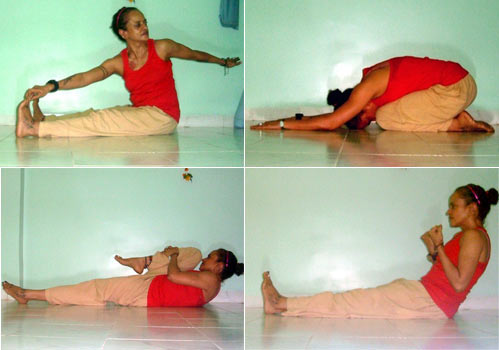

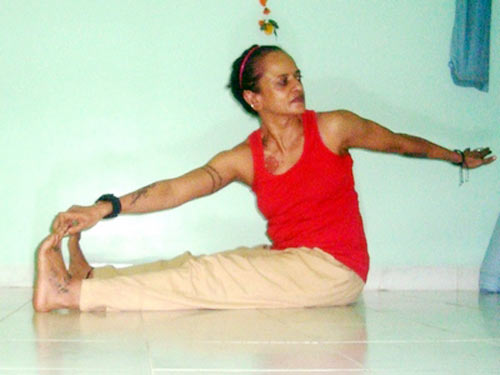
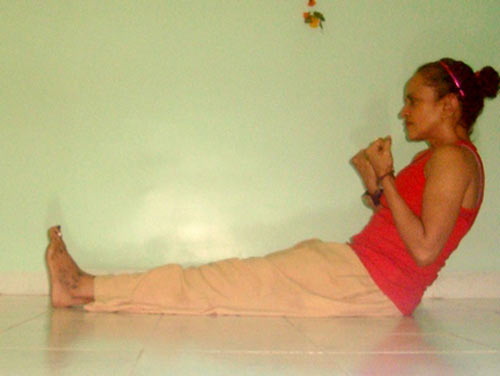
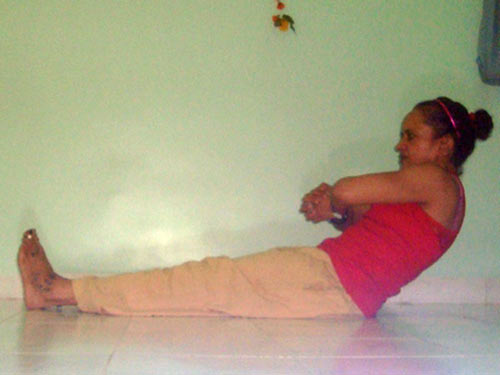
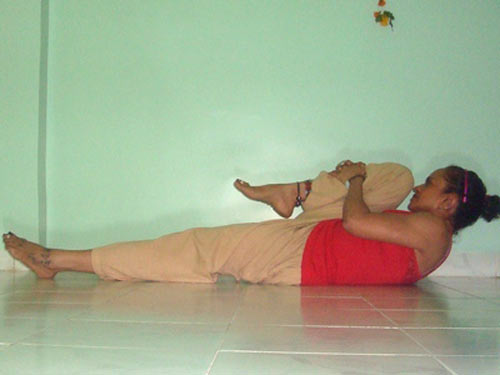
Comment
article